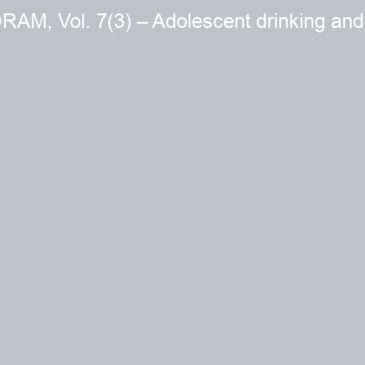Benign breast disease (BBD) is a risk factor for breast cancer, and evidence indicates that adult alcohol intake among postmenopausal women increases risk of BBD and breast cancer (e.g., Longnecker, Berlin, Orza, & Chalmers, 1988; Zhang, Lee, Manson, Cook, Willett, & Buring, 2007). Further, young adult alcohol consumption (i.e., ages 18-22) is associated with BBD later in life (Bryne, et al., 2002). This month, the DRAM reviews the first prospective examination of the relationship between adolescent alcohol consumption and BBD (Berkey et al., 2010).
Methods
- The Growing Up Today Study (GUTS) began in 1996.
- A nationwide sample of 9,037 girls, age 9 to 15, who were daughters of Nurses’ Health Study II participants, was enrolled at baseline.
- The participants completed questionnaires annually from 1996 through 2001, as well as follow-up surveys in 2003, 2005, and 2007.
- The 2003 survey, administered when the subjects were 16 to 23 years old, provided information about their alcoholic beverage consumption in the previous year, specifically:
- Drinking frequency – how often they consumed alcohol
- Drinking quantity – how much alcohol they consume on drinking occasions
- Binge drinking – how often they consume 4+ drinks within a few hours
- 6,899 women completed both the 2005 and 2007 surveys, administered when the women were 18 to 27 years old. These surveys indicated whether a health care provider had ever diagnosed them with BBD and whether it was confirmed by biopsy.”
- Berkey et al. (2010) conducted logistic regression analyses to examine the association between BBD and adolescent alcohol consumption. All models were adjusted for body mass index (BMI) and exact age (to the month).
Results
- Sixty-seven (1.0%) of the 6,899 women included in analysis were biopsy-confirmed BBD cases.
- The Figure presents alcohol consumption data for BBD and non-BBD cases.
- The primary logistic regression analysis, controlled for age, found that risk for BBD increased with more frequent alcohol consumption; frequency appeared more important than quantity.
| No BBD
(n = 6752) |
BBD (Biopsy Confirmed)
(n = 67) |
Risk for BBD (Odds Ratio from Age adjusted Model [95% CI]) | |
| Average age at alcohol report in 2003 | 19.3 | 20.0 | |
| Drinking frequency (%) | |||
| < once/week | 75.9 | 54.9 | 1.0 (Referent) |
| 1-2 days/week | 18.7 | 27.5 | 1.6 (0.8-3.1) |
| 3-5 days/week | 4.8 | 13.7 | 3.0 (1.3-7.1)* |
| 6-7 days/week | 0.7 | 3.9 | 5.5 (1.2-24.5)* |
| Drinks consumed / drinking occasion | 2.4 | 2.8 | 1.1 (0.9-1.2) |
| Drinks/day (frequency*quantity) | 0.4 | 0.8 | 1.5 (1.2-1.9)* |
| # of bingeing occasions, past year | 4.7 | 6.4 | 1.0 (1.0-1.1) |
| Binge = 12 times during previous year, (%) | 20.9 | 42.3 | 1.5 (0.8-2.9) |
Figure, Alcohol consumption in 2003 by BBD case status (adapted from Berkey et al., 2010). Model adjusted for age and BMI. *p < .05. Click image to enlarge.
Limitations
- Investigators relied on participants’ self-reports of their alcohol consumption.
- Because little is known about childhood/adolescent risk factors for BBD, the authors could not exclude the possibility that there are other confounding variables.
- The study participants were daughters of nurses; thus, they might not be representative of US women.
Conclusions
This study was the first to examine the relationship between alcohol intake during adolescence and BBD; the results are consistent with previous retrospective studies finding a relationship between BBD and alcohol consumption at later ages (e.g., Longnecker et al., 1988; Zhang et al., 2007). Specifically, this study found a positive association between alcohol consumption (frequency, and to a lesser extent, quantity) and subsequent BBD. However, it is important to note that among the women with confirmed cases of BBD, over 50% reported that they abstained from alcohol or drank infrequently. Future research should continue to explore risk factors for BBD, including alcohol intake.
— Matthew Hojatzadeh (Matthew is a special contributor to the BASIS and a graduate student at East Carolina University)
What do you think? Please use the comment link below to provide feedback on this article.
References
Berkey, C., Willett, W., Frazier, L., Rosner, B., Tamimi, R., Rockett, H., & Colditz, G. (2010). Prospective Study of Adolescent Alcohol Consumption and Risk of Benign Breast Disease in Young Women. Pediatrics, 125(5). 1081-1087.
Bryne, C., Webb, P., Jacobs, T., Peiro, G., Schnitt, S., Connolly, J., Willett, W., & Colditz, G. (2002). Alcohol Consumption and Incidence of Benign Breast Disease. Cancer Epidemiology Biomarkers Preview, 11(11). 1369-1374.
Longnecker, M., Berlin, J., Orza, M., & Chalmers, T. (1988). A Meta-Analysis of Alcohol Consumption in Relation to Risk of Breast Cancer. JAMA, 260(5). 652-656.
Vachon, C., Kushi, L., Cerhan, J., Kuni, C., & Sellers, T. (2000). Association of Diet and Mammographic Breast Density in the Minnesota Breast Cancer Family Cohort. Cancer Epidemiology, Biomarkers and Prevention, 9(2). 151-160.
Zhang, S., Lee, I., Manson, J., Cook, N., Willett, C., & Buring, J. (2007). Alcohol Consumption and Breast Cancer Risk in the Women’s Health Study. American Journal of Epidemiology, 165(6). 667-676.




